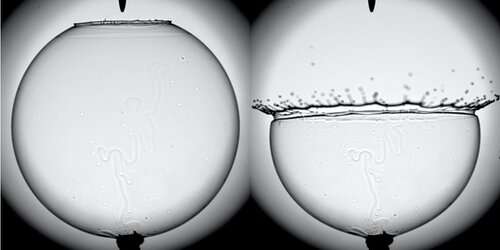Credit: A. Bussonnière et al., Phys. Rev. Lett. (2020)
A team of researchers from Sorbonne Université and the University of Lille has measured the sounds that occur when a soap bubble pops. In their paper published in the journal Physical Review Letters, the group describes the action as it unfolds and the sounds that are emitted as ordinary soap bubbles pop.
As scientists seek to understand the processes that are involved in large events such as volcanoes erupting, they often turn to smaller events that have similar properties, but are much easier to study. In this instance, the researchers looked to better understand the mechanics of bubbles popping and ways the action can be measured.
To gain a better perspective on bubble popping, the researchers created an environment where bubbles could be created and popped on demand. They then filmed the action using high-speed cameras and recorded the noises that were emitted using sensitive microphones.
By watching the bubbles popping in slow motion, the researchers were able to see that the burst began with the initial rupture. As the rupture continued, the film that made up the walls of the bubbles began to retract along the boundary where the walls once existed. As they did so, the film grew thicker as it absorbed more of the material that had made up the bubble walls. And as the walls retracted, air inside the bubble was pushed out. This was because the air inside of a bubble is held under a small amount of pressure due to the capillary forces arising from surface tension. Eventually, the walls all gave way, and the liquid fell back into the soapy solution used to make the bubbles.
The researchers also found that when a hole was created in the bubble, the forces that held it together became unbalanced, resulting in the rim surrounding the hole retracting and making the hole widen. The end result was a force on the air just outside of the bubble with strength varying depending on the size of the hole as it grew. Also, by listening to the recordings, the researchers found they were able to make out two distinct sounds: the walls retracting and the air rushing out of the bubble. Then, by using the sounds they had recorded, they developed a model that could be used to predict the thickness of the bubble walls, where the rupture had been located on the bubble and several other properties of the initial bubble.
More information: Acoustic Sensing of Forces Driving Fast Capillary Flows, Physical Review Letters (2020). journals.aps.org/prl/abstract/ … ysRevLett.124.084502
Journal information: Physical Review Letters
© 2020 Science X Network
























